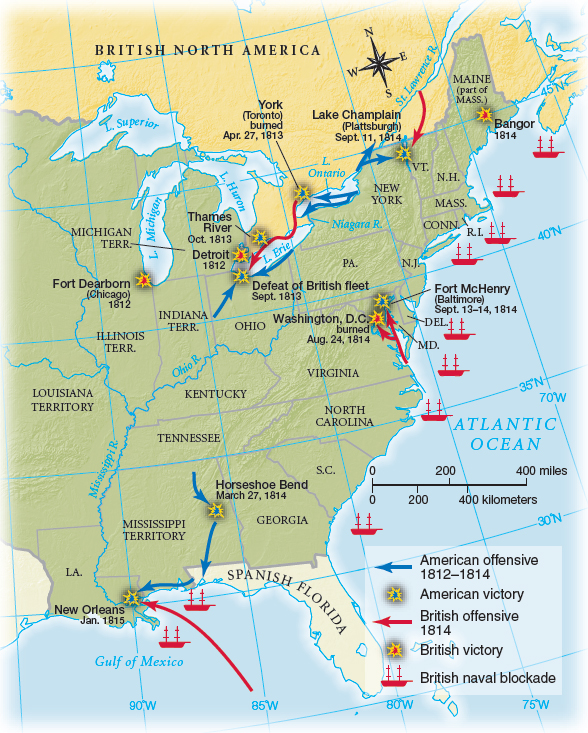The War of 1812
Printed Page 276
The Indian conflicts in the old Northwest soon merged into the wider conflict with Britain, now known as the War of 1812. Between 1809 and 1812, Madison teetered between declaring either Britain or France America’s primary enemy, as attacks by both countries on U.S. ships continued. In 1809, Congress replaced Jefferson’s embargo with the Non-Intercourse Act, which prohibited trade only with Britain and France and their colonies, thus opening up other trade routes to alleviate the economic distress of American shippers, farmers, and planters. By 1811, the country was seriously divided and on the verge of war.
The new Congress seated in March 1811 contained several dozen young Republicans from the West and South who would come to be known as the War Hawks. Led by thirty-four-year-old Henry Clay from Kentucky and twenty-nine-year-old John C. Calhoun from South Carolina, they welcomed a war with Britain both to justify attacks on the Indians and to bring an end to impressment. Many were also expansionists, looking to occupy Florida and threaten Canada. Clay was elected Speaker of the House, and Calhoun won a seat on the Foreign Relations Committee. The War Hawks approved major defense expenditures, and the army soon quadrupled in size.
 Young men newly elected to the Congress of 1811 who were eager for war against Britain in order to end impressments, fight Indians, and expand into neighboring British territory. Leaders included Henry Clay of Kentucky and John C. Calhoun of South Carolina.
Young men newly elected to the Congress of 1811 who were eager for war against Britain in order to end impressments, fight Indians, and expand into neighboring British territory. Leaders included Henry Clay of Kentucky and John C. Calhoun of South Carolina.
In June 1812, Congress declared war on Great Britain in a vote divided along sectional lines: New England and some Middle Atlantic states opposed the war, fearing its effect on commerce, while the South and West were strongly for it. Ironically, Britain had just announced that it would stop the search and seizure of American ships, but the war momentum would not be slowed. The Foreign Relations Committee issued an elaborate justification titled Report on the Causes and Reasons for War, written mainly by Calhoun and containing extravagant language about Britain’s “lust for power,” “unbounded tyranny,” and “mad ambition.” These were fighting words in a war that was in large measure about insult and honor.
The War Hawks proposed an invasion of Canada, confidently predicting victory in four weeks. Instead, the war lasted two and a half years, and Canada never fell. The northern invasion turned out to be a series of blunders that revealed America’s grave unpreparedness for war against the unexpectedly powerful British and Indian forces (Map 10.3). By the fall of 1812, the outlook was grim.

Worse, the New England states were slow to raise troops, and some New England merchants carried on illegal trade with Britain. The fall presidential election pitted Madison against DeWitt Clinton of New York, nominally a Republican but able to attract the Federalist vote. Clinton picked up all of New England’s electoral votes, with the exception of Vermont’s, and also took New York, New Jersey, and part of Maryland. Madison won in the electoral college, 128 to 89, but his margin of victory was considerably smaller than in 1808.
In late 1812 and early 1813, the tide began to turn in the Americans’ favor. First came some victories at sea. Then the Americans attacked York (now Toronto) and burned it in April 1813. A few months later, Commodore Oliver Hazard Perry defeated the British fleet at the western end of Lake Erie. Emboldened, General Harrison drove an army into Canada from Detroit and in October 1813 defeated the British and Indians at the battle of the Thames, where Tecumseh was killed.
CHAPTER LOCATOR
How did Jefferson attempt to undo the Federalist innovations of earlier administrations?
What was the significance of the Louisiana Purchase for the United States?
Why did Congress declare war on Great Britain in 1812?
How did the civil status of American women and men differ in the early Republic?
Why did partisan conflict increase during the administrations of Monroe and Adams?
Conclusion: How did republican simplicity become complex?
 LearningCurve
LearningCurve
Check what you know.
Creek Indians in the South who had allied with Tecumseh’s confederacy were also plunged into war. Some 10,000 living in the Mississippi Territory put up a spirited fight against U.S. forces for ten months. But the Creek War ended suddenly in March 1814 when a general named Andrew Jackson led 2,500 Tennessee militiamen in a bloody attack called the Battle of Horseshoe Bend. More than 550 Indians were killed, and several hundred more died trying to escape across a river. Later that year, General Jackson extracted from the defeated tribe a treaty relinquishing thousands of square miles of their land to the United States.
 Part of the War of 1812 involving the Creek nation in the Mississippi Territory and Tennessee militiamen. General Andrew Jackson’s forces defeated the Creeks at the Battle of Horseshoe Bend in 1814, forcing them to sign away much of their land.
Part of the War of 1812 involving the Creek nation in the Mississippi Territory and Tennessee militiamen. General Andrew Jackson’s forces defeated the Creeks at the Battle of Horseshoe Bend in 1814, forcing them to sign away much of their land.